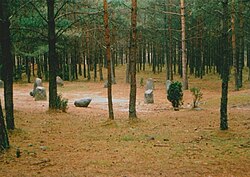
The stone circles of the Iron Age (c. 500 BC – c. 400 AD) were a characteristic burial custom of southern Scandinavia and Southwestern Finland, especially on Gotland and in Götaland.
Finland court stones are found in Eura, Ulvila and Kokemäki. They date typically during the Pre-Roman Iron Age and the Roman Iron Age. In Sweden, they are called Domarringar (judge circles), Domkretsar (judge circles) or Domarsäten (judge seats). In Finland they are called Käräjäkivet (court stones). In some places in Nordic countries they were used until 17th century.
They should not be confused with earlier bronze age and neolithic Stone circles in the British Isles and Brittany.
History

A tradition of making stone circles existed on the European continent in Wielbark culture near the mouth of the Vistula River in the first century. The practice suggests Norse influence but may have been established in the area before the arrival of the Goths.
The stone circles were sometimes used as burial grounds.
Shapes
The circles are usually round, or elongated ellipses. The stones may be very large and they are usually between 9 and 12. Sometimes there are as few as 6–8. One stone circle, the circle of Nässja (near Vadstena), comprises as many as 24 stones. Excavations have shown burnt coal in the centre of the circles and they are nowadays considered to be incineration graves.
Things
There is a widespread tradition that the circles were used for things, or general assemblies. Similar circles were used for popular assemblies in Denmark until the 16th century, and in Vad parish in Västergötland, the village assemblies were held in a stone circle until the 19th century.
Snorri Sturluson
Even if knowledge that the stone circles were graves was later lost, it was still fresh in the 13th century as testify these lines by Snorri Sturluson in the introduction of the Heimskringla:
As to funeral rites, the earliest age is called the Age of Burning; because all the dead were consumed by fire, and over their ashes were raised standing stones.
— Heimskringla by Snorri Sturluson
Examples
- Gettlinge burial field, Öland, Sweden
- Hulterstad burial field, Öland, Sweden
- Jelling stones, Vejle, Denmark
- Käräjämäki, Eura, Finland
- Käräjämäki, Kokemäki, Finland
- Liikistö, Ulvila, Finland
- Stoplesteinan, Norway
- Odry, Pomerania, Poland
- Węsiory burial field, Kashubia, Poland
See also
References
- "Page:The Heimskringla; or, Chronicle of the Kings of Norway Vol 1.djvu/226 - Wikisource, the free online library". en.wikisource.org. Retrieved 2021-07-17.
- Háskólabókasafn, Landsbókasafn Íslands-. "Bækur.is". baekur.is (in Icelandic). Retrieved 2021-07-17.
Sources
- Nationalencyklopedin
- A Polish Archaeology Article by Tadeusz Makiewicz
- ADuong's a history of Poland
![]() This article contains content from the Owl Edition of Nordisk familjebok, a Swedish encyclopedia published between 1904 and 1926, now in the public domain.
This article contains content from the Owl Edition of Nordisk familjebok, a Swedish encyclopedia published between 1904 and 1926, now in the public domain.